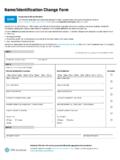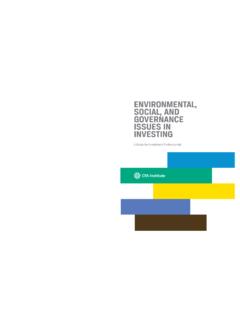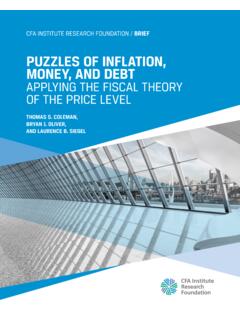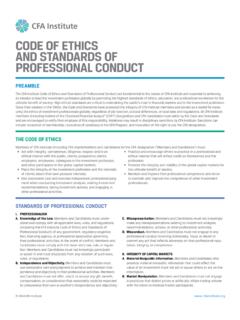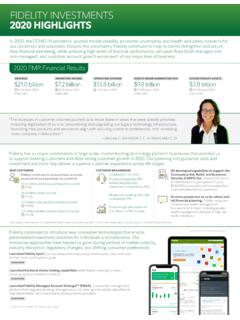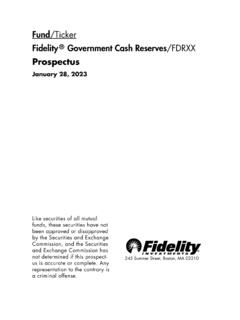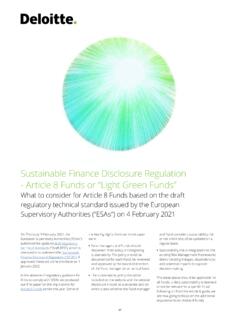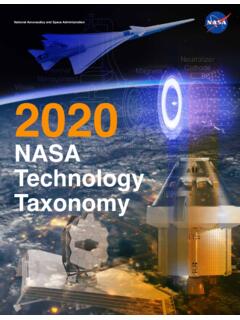Transcription of Guide to 2022 CFA Program Curriculum Changes
1 Guide to 2022 CFA Program CurriculumChanges Contents1 2 FOREWORD5 KEY Changes IN LEVEL I6 Quantitative Methods7 Economics7 Financial Statement Analysis8 Corporate Issuers (Formerly Corporate Finance)9 Equity Investments9 Fixed Income9 Derivatives9 Alternative Investments10 Portfolio Management11 Ethical and Professional Standards12 KEY Changes IN LEVEL II13 Quantitative Methods14 Economics14 Financial Statement Analysis14 Corporate Issuers (Formerly Corporate Finance)15 Equity Valuation15 Fixed Income16 Derivatives16 Alternative Investments17 Portfolio Management17 Ethical and Professional Standards18 KEY Changes IN LEVEL III19 Behavioral Finance 19 Capital Market Expectations19 Asset Allocation and Related Decisions in Portfolio Management19 Derivatives and Currency Management20 Fixed-Income Portfolio Management20 Equity Portfolio Management20 Alternative Investments for Portfolio Management21 Private Wealth Management22 Portfolio Management for Institutional Investors22 Trading, Performance Evaluation, and Manager Selection22 Cases in Portfolio Management and Risk Management23 Ethical and Professional Standards2 A key CFA Institute strategy is to ensure that the CFA Program Curriculum equips candidates with current, relevant knowledge and skills that reflect investment management practice.
2 To deliver on this strategy, we keep our learners at the center of everything we do. Foreword3 As part of our commitment to prioritizing the interests of our candidates, CFA Institute reduced the impact of pandemic-related exam disruptions by freezing the 2020 CFA Program Curriculum for 2021 exam administrations. This meant that all candidates who took exams in 2021 were tested on the 2020 CFA Program Curriculum . Despite this freeze for candidates, the Curriculum continued to evolve. Extensive work through practice analysis and Curriculum development has resulted in virtually all levels of the Curriculum being updated or revised within the past four years. We have updated data exhibits, added new cases, streamlined readings to be better learning experiences, and improved end-of-reading questions. All of these efforts better align the CFA Program Curriculum with what CFA charterholders do daily on the job.
3 We can safely say that the CFA Program Curriculum today is the most up-to-date Curriculum since it was established in 1963. CFA Program Level I Curriculum was updated broadly in 2020 and the Level II Curriculum was updated in 2022. Significant Changes between the 2020 Curriculum and the new 2022 Curriculum are as follows: The Ethical and Professional Standards topic area has moved to the end of each level and an Applications reading has been added to each level that explicitly shows the Code and Standards in operation on topics and material covered in Curriculum content for that level. Environmental, social, and governance (ESG) coverage at Level I was updated and expanded to cover the most recent developments and their impact on investment management. The Level I Quantitative Methods topic area was revised to be more engaging and digital-friendly and now includes code snippets as well as Excel commands to support the data presentation.
4 Level I now ends with a new Introduction to Regression reading that focuses on investment applications. At Level II, Machine Learning has been updated to apply several data cases to investment problems. In addition, a new Backtesting & Simulation reading provides a sophisticated but accessible introduction to explain how these tools are used in evaluating investment strategies and to compare their strengths and weaknesses. The Corporate Finance topic area has transformed into Corporate Issuers at Levels I and II. The focus of the new Corporate Issuers topic area is on understanding the motivations, interactions, and impacts on investors of securities issued by corporations. Corporate Issuers brings together foundation areas like economics and financial statement analysis to provide a jumping off point for equity and fixed-income valuation. The Fixed Income readings across Levels I, II, and III have been revised and aligned for consistency.
5 This includes notation simplification and alignment, elimination of duplication, and updating of concepts such as LIBOR to Market Reference Rates, as well as a complete revision of the challenging Yield Curve Strategies and Credit Strategies readings at Level III for clarity and relevance. The Alternative Investments readings have been updated at Levels I and II, including a new introductory reading at Level I, and revisions to Private Equity and a single reading on real estate at Level II. The Level III readings have been extensively revised, replacing old content and refocusing on new content that captures current practice. The majority of readings at Level III are less than four years old. The significant Changes and revisions to Private Wealth Management, Institutional Investors, and Performance Evaluation reflect the new 2020 Global Investment Performance Standards (GIPS Standards). Guide to 2022 CFA Program Curriculum Changes | Foreword3 As the investment profession evolves, we have evolved our learning environment to keep pace between 2020 and 2022.
6 Our Learning Ecosystem (LES) a cutting-edge digital platform that consolidates the entire Curriculum and all study tools including practice question bank and mock exams features a personalized study plan that can adjust the learning path to suit individual strengths and weaknesses. The LES is the primary method by which we offer candidates access to all levels of the CFA Program . Moving to digital-first delivery of the CFA Program Curriculum increases the accessibility of our programs globally, modernizes the learning experience, aligns with our move to computer-based testing (CBT), and supports us in maintaining fidelity to understand that our candidates faced deferrals and other circumstances that may have prevented them from completing the CFA Program on the timeline they would have liked and acknowledge that these updates to the Curriculum mean they will be tested on new content. We trust you will agree that the adjustments made to the Curriculum reflect current practice and will prepare you well for what you will encounter in the Guide highlights Changes to the Curriculum over the past two years.
7 As you revisit the Curriculum , you will better understand and feel prepared to take on your next CFA Program Veitch, CFAHead, Learning Content and ExperienceGuide to 2022 CFA Program Curriculum Changes | Foreword4 5 Key Changes in Level IAt a Glance5 # of unchanged readings# of updated readings# of revised readings# of new, extensively revised, or added readingsQuantitative Methods1024 Economics5200 Financial Statement Analysis11010 Corporate Issuers 1023 Equity Investments4020 Fixed Income0060 Derivatives 2000 Alternative Investments0001 Portfolio Management5003 Ethical and Professional Standards2021 Visit our website for more information about Changes to the 2022 Level I Quantitative MethodsThe Time Value of MoneyNo ChangesStatistical Concepts and Market ReturnsDroppedOrganizing, Visualizing, and Describing DataNewProbability ConceptsRevisionCommon Probability DistributionsMajor RevisionSampling and EstimationRevisionHypothesis TestingComplete RevisionIntroduction to Linear RegressionComplete RevisionGuide to 2022 CFA Program Curriculum Changes | Key Changes in Level IInvestment firms are increasingly using technology across the investment management value chain from improving their understanding of clients, to uncovering new sources of alpha and executing trades more efficiently.
8 A data-rich environment offers tremendous opportunities for investors, but turning data into useable information is not straightforward. Organizing, cleaning, and analyzing data are crucial to the development of successful investment strategies: otherwise, analysts risk a garbage in, garbage out scenario in which expected outcomes do not materialize in the real world. The new Organizing, Visualizing, and Describing Data reading provides the foundation for data-driven quantitative methods, such as backtesting, simulation, machine learning, and big data projects. This reading covers a number of visualization techniques, such as tree maps, word clouds, and heat maps, which are key to understanding the inputs and outputs of investment analyses and strategies. The reading also contains a wealth of visuals and graphics to aid understanding of the application of technology in the investment and streamlined coverage of key probability concepts, supported by new engaging visuals, graphics, and flowcharts are key elements of the revised Probability Concepts reading.
9 The tools that allow us to make decisions with consistency and logic in an investment landscape loaded with risk are based on probability concepts. The revised reading presents the essential probability tools needed to frame and address many real-world problems. These tools can be applied to a variety of issues, such as predicting investment manager performance, forecasting financial variables, and pricing bonds so they fairly compensate bondholders for default risk. The reading features plenty of theory, but the focus is resolutely on the practical applications. A revised Common Probability Distributions reading consolidates discussion of a range of key probability distributions. Also included are engaging visuals, graphics, and flowcharts to aid understanding of concepts. Analysts are accustomed to using sample information to assess, for example, how stock markets around the world are performing.
10 In addition to updating and streamlining coverage of existing key sampling and estimation concepts, a revised Sampling and Estimation reading introduces important new sampling techniques. The central limit theorem and estimation, the core method presented in the reading, may be used for many investment applications. The reading helps with the interpretation of statistical results based on financial data as well as with the possible pitfalls of this many engaging visuals, graphics, and flowcharts in the new Hypothesis Testing reading will aid in the selection of appropriate test statistics and in a better understanding of concepts. The six-step framework and other new content make this reading important for any future analyst or investment professional who may use hypothesis testing in their decision-making processes. This framework will now be used throughout the CFA Program Curriculum for hypothesis testing in other topic introduction to indicator variables and the presentation of different functional forms for simple linear regression models form an important part of the new Introduction to Linear Regression reading.
